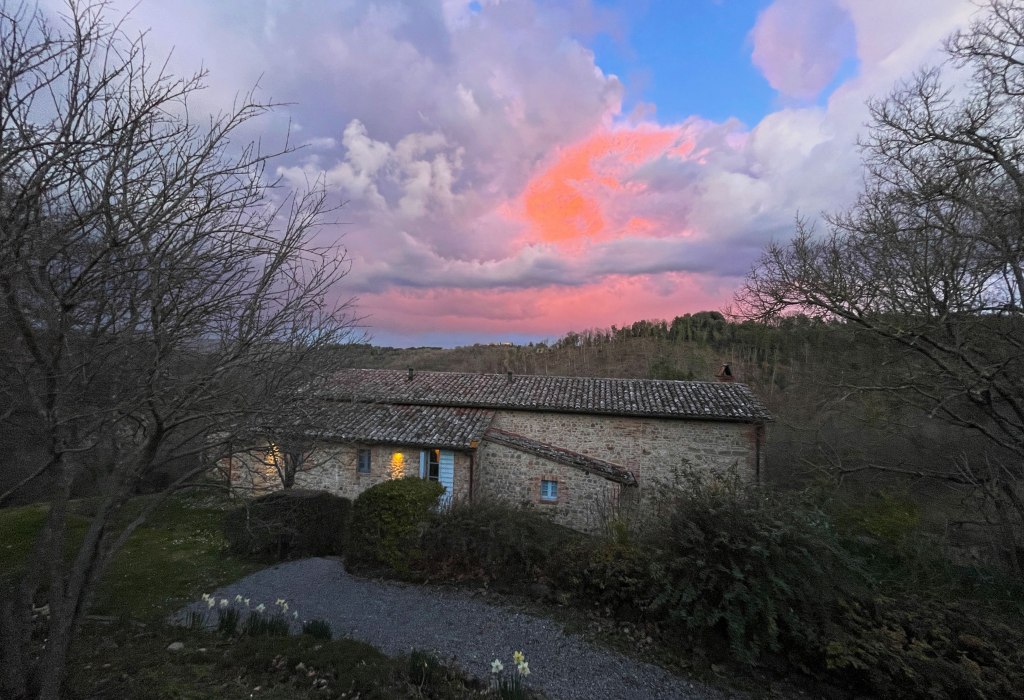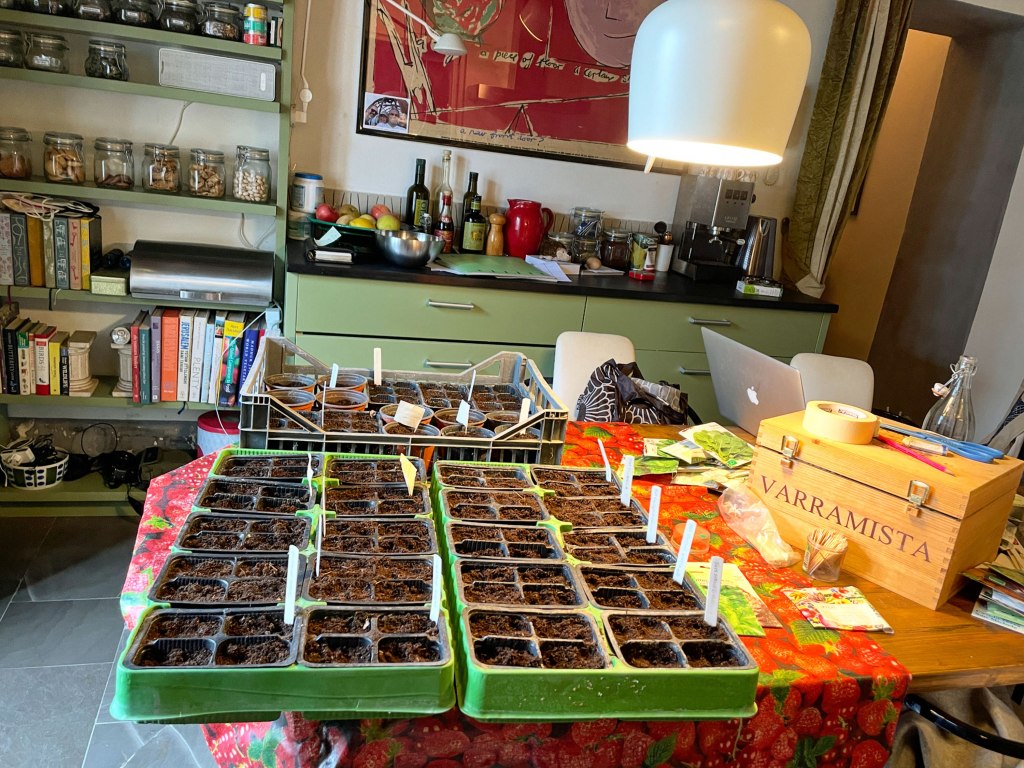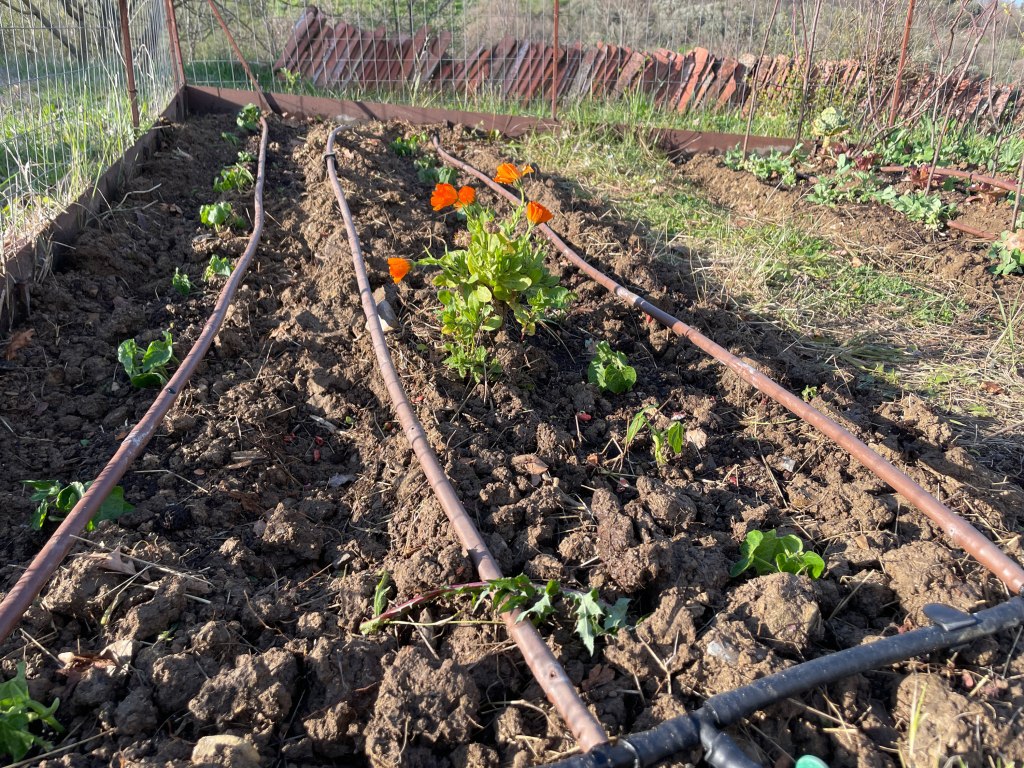
The other evening I hit a deer. It was just along by Mario Draghi’s gate, where I’d seen deer bounding across the road on other occasions. This one was obscured by an oncoming car as I made my way home: luckily, it was moving fast and by the time I made contact with it, it was almost on the verge.
I clipped its haunch and swerved it round a bit, and it gave me a momentary wide-eyed-shock look. I suspect I was looking pretty taken aback too. But my emergency braking went smoothly and the afflicted animal hauled itself up on to the verge and trotted away. No damage, no fuss. I bet it had a pretty sore rear end for a few days.
Since then I’ve been wondering: what exactly was it that I hit? We have lots of caprioli (Capreolus capreolus – Roe deer) bobbling round in our field, and zipping across our lane as if they were lying in wait there, daring each other to run in front of passing vehicles. But our speed on our bumpy track tends to be slow, so I never feel there’s much danger of contact.
When they’re close enough, and they move about, it’s not difficult to identify caprioli, with their perky white bottoms. They do stand out brightly.
We also, though, have cervi (Cervus elaphus – Red deer), or so I’m told. These are recognisable by virtue of being enormous, and having – in the male of the species – bloody big horns. L maintains he once spotted a stag in full fag down in our field, and that’s perfectly possible. I can’t say that I’ve ever seen one.
It’s tempting of course to think that what I hit was a noble cervo: it certainly looked pretty huge at the time of impact. But I rather suspect it was a humble capriolo which isn’t quite so impressive. Still, it’s probably solid enough to make a large dent in your bonnet in the event of a full-on hit.
It’s odd how animals you have to face up to against your will tend to look so immense. We often, for example, have field mice in our chicken house. (No chickens… that’s just what the outbuilding is called.) They’re kind of annoying in that they nibble on anything made of plastic, including the handlebar covers on my bike, various bits of the lawnmower, wellies and big bottles of very expensive organic products to spray on plants. They have to keep gnawing, apparently, because their incisors never stop growing and need to be constantly ground down, which makes anything you happen to have lying about fair game for them. As they are (mainly) quiet and retiring, and scurry away whenever humans are about, I can (mainly) resign myself to this, bravely telling myself that they too have a right to live in this rural idyll. Grrrrr
Rats, on the other hand, are a different kettle of fish. We get them very rarely, thank goodness. But the one which stared up at me a couple of weeks ago as I lifted the cover off the compost bin it was ransacking, and looked down at me menacingly from the rafters of the chicken house, was the size of a small cow. It was. I swear. Well, you know… it was far bigger than it should have been.

So I decided it had to go. I don’t like killing animals (except ants). But… there are red lines. This creature had not just nibbled genteely at the plastic tops of my organic product bottles: it had chomped right through the bottle itself, decorating the chicken house floor with great puddles of exorbitant liquid.
I went to the hardware shop to purchase the most lethal thing they had. The lady in there waved ‘humane traps’ at me, but I told her my humanity had withered at the sight of a cow-sized rat. I wanted instant death.
Her husband produced a packet of rodent bait, of the one-bite-and-you’re-dead variety. Perfect. It took a while to get out of the store. He had to tell me his rodent tale. Because everybody has one. His was a humble mouse, but a mouse which got into his car, made its way into the glove compartment and consumed all his car documents. By chance he was stopped at a police road block soon after. Instead of docs all he could produce was some shredded paper with large dollops of mouse droppings. So he was fined for having no documents and had to pay a huge whack for fast-tracking the new papers. He was happy – nay, eager – to help me with my carnage.
The instructions said to leave one tablet somewhere the rodent could access it easily. I left five. Next morning, they had all gone. So that evening, just to be safe, I put down five more. Next morning they were gone. Part of me was worried that these tablets were turning my beast into super-rat: that I’d open the chicken house door and meet it eye to eye. The other part thought: just die, will you?
I forgot to distribute more destruction that evening. No matter. Ratty went ahead and helped himself: the following morning there was no sign of the carefully sealed plastic bag I had left on a top shelf. Surely, surely, now it must be dead.
It was two or three days later, as I was removing the covers from the citruses which had over-wintered in the chicken house, that I noticed a small trembling ball of fur creeping vertically up the crumbling wall at the back of the building. Brick by sandy brick, it was hauling itself straight up: one false paw step and it would crash right down again. Here was my much-reduced rat, shrunken and clearly on its way out.
The next day L found the corpse somewhere in the chicken house. I didn’t want to know where. With 15 times the recommended dose of poison inside it, the creature had finally expired. Was I sorry? Did I feel guilty? Of course I didn’t. It was a rat.
A brief aside about things we’re addicted to without knowing. No, not Wordle or doom-scrolling: I know only too well that they have me in their clutches. In this case: sugar.
I don’t really do diets. But I do do experiments. As I thought I was eating too much chocolate (it’s a busy time of year for a garden designer: I needed energy) I decided to take action. I don’t have the self-discipline for a softly softly approach. I’m an all-or-nothing person. So I gave up sugar.
If you’re doing this properly you give up anything with any variation on sugar, including fruit. But life is hardly worth living without fruit. So I drew my line at anything with added processed sugar in it. Fine.
Effect? Well, I was thinking it was all rather a damp squib. It really didn’t seem to make the blindest bit of difference. No weight lost (even now, after a couple of months, which is rather odd). All in all I felt more or less the same. Oh, except for some headaches but those, I thought, were incidental. My total sugar ban was so much an integral part of my life by the time I started feeling that something was trying to break out of the back of my head with an axe that I failed to put the two together. But oh, they went together. I had booked an appointment with my doctor before the penny dropped. I googled. Yes, debilitating headaches from sugar cold turkey is a thing.
And so I know that when they say that processed foods are packed with sugar (and salt) to get people hooked, it’s not just a turn of phrase. There’s real dependence there.
Spring seems to be here. Of course plenty of recent experience tells us that it may not be here definitively: my terror of a Big Freeze is holding me back on various plantings in various gardens. You just never know when the all clear will be any more.
What can be safely done however, I’m doing.
On the March new moon I got some seeds into pots: my summer tomatoes and beans and courgettes and peppers are already pushing through and unfurling in my falling-to-pieces little greenhouse out there.
I cheated and bought pea plants. They’re in the ground, refusing as always to climb the handy sticks I’ve provided for them, many of which are flowering picturesquely and probably putting down roots: they’re the clippings from some rushed and inadequate fruit tree pruning that I did last weekend. The first lot of green beans are in the ground too – purchased, I admit, from the man with the plant van in our Saturday market.
We’ve eaten our first asparagus, and had our first comfortable lunch outside. (I say comfortable because there were cold-but-bright days in winter where we shivered over a plate outside because it just felt so glorious to be in the sun.) We’ve broken out the sunscreen for prolonged bouts in the outside world.
I’ve found a solution for my despair over the state of the garden, in the shape of a lovely lady who used to help me in the house but went on to better things. Now she has time on her hands so she’s agreed to help with weeding and tidying and generally getting things how I never have time to make them.
I told her I really needed a woman to help me because I was sick to death of soi-disants ‘gardeners’ (male of course) who couldn’t envisage being in the garden without a strimmer or some other noisy powertool in their hands. I wanted someone with patience and sense. She laughed and prevaricated, but finally turned up.
I don’t know whether she came out of compassion, or because she liked the idea of weeding for me, or whether she suddenly realised that my utter disillusion with male gardeners was serious. A relation, she told me, had brought her back a collection of seeds for salad greens from Romania. They were special: delicious and spicy, including leaves that you don’t find in Italy. They were just coming up, almost ready to eat. And what did her husband do? He hadn’t realised she’d seeded them where she’d seeded them. So he went at the unruly row with his strimmer and removed the lot. At that point she realised that my need was real.












